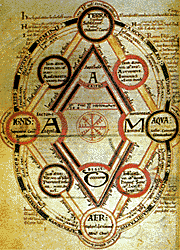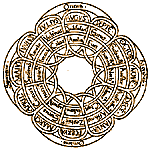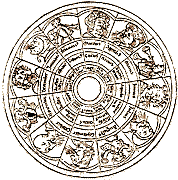
THE UNIVERSE DIVIDED INTO FOURS
In our latter-day curiosity cabinet we created certain groupings of objects to
reflect some of the principle organizing rubrics of the sixteenth century. It
is important to remember that in their own day these organizing devices were
seen as conveniences rather than as fixed categories. As in any classification
system, the basic purpose was to create order out of chaos, to allow the
efficient storage and retrieval of individual items, at least as much as it was
to explicate the material being stored.
 Both then and now, the associations which result in this or that object being
grouped under a given heading are unstable, as are the categories themselves.
Some slippage always occurs between the world and the microcosm which
represents it, and this is the motivating force behind shifts in our
understanding of what the world is. While there was an attempt to create a
poetic symmetry and consistency in the structure of sixteenth-century world,
the inevitable tendency of divisions to break down under pressure was not only
tolerated, but celebrated.
Both then and now, the associations which result in this or that object being
grouped under a given heading are unstable, as are the categories themselves.
Some slippage always occurs between the world and the microcosm which
represents it, and this is the motivating force behind shifts in our
understanding of what the world is. While there was an attempt to create a
poetic symmetry and consistency in the structure of sixteenth-century world,
the inevitable tendency of divisions to break down under pressure was not only
tolerated, but celebrated.
The most fundamental conceptual division in a sixteenth-century Curiosity Cabinet was between Naturalia and Artificialia, those objects created by nature and those shaped by the hand of man. This distinction emphasized the special status of human consciousness and its products within the cosmic order, and was linked to a new view of human purpose in the world; no longer a mere spectator attempting to read the text of God's creation, the individual was now seen as an active participant granted the divine gift of creativity, able to draw power from and to reproduce the natural world. The collection, then and now, can be seen as the point of intersection between the natural world of matter and the human intellect that organizes objects into meaning.
The relationship between Naturalia and Artificialia reflected that of the macrocosm and microcosm: nature was recapitulated in human artifacts; the order of the cosmos was reiterated in that of the human body. The truth of this relationship was revealed in those things which blurred the distinction between art and nature: shells which demonstrated architectural principles, crystals which formed perfect geometrical solids, natural patterns which rivalled the creation of painters, and human crafts which mimicked nature.
The sixteenth-century world was further subdivided, often into clusters of
four, based on universalizing rubrics. There were, for example, four seasons,
four human temperaments (melancholic, sanguine, choleric and phlegmatic), four
elements (earth, air, water, and fire), four cardinal directions, and (so it
was believed) four continents (Europe, Asia, Africa and America).
 Other common divisions were the seven liberal arts and the seven planets.
Nearly all of nature and human artifice could be classed under one or another
of these headings. The process of assigning objects to rubrics such as the
four elements could be either very direct or very obscure; sometimes myths were
the source of the connection, sometimes it was just appearance.
Other common divisions were the seven liberal arts and the seven planets.
Nearly all of nature and human artifice could be classed under one or another
of these headings. The process of assigning objects to rubrics such as the
four elements could be either very direct or very obscure; sometimes myths were
the source of the connection, sometimes it was just appearance.
As with the four elements, the four continents could be used as global
categories for organizing collections. Each continent was associated with a
cardinal direction and had its own complement of peoples, animals, plants,
arts, religions and so forth, which could form thematic sub-categories for the
representative objects. As new lands, peoples and materials were gradually
discovered, geographers had to restructure their maps of the world, and
collectors had to reorganize their collections. Of course, later exploration
determined that America should properly be divided into two continents, and
then revealed Australia and eventually Antarctica. This upset the "natural"
division of the world into balanced parts.
 The four seasons could also be used as a primary basis for organizing a
collection. Each season had its own human festivities and events, its own
appropriate crafts and chores, its own flora and fauna.
As a cycle, the seasons both encompass the entire sphere of human and natural
activities--in effect, circumscribe the cosmos--and indicate that repetition is
a quality of time as
well as of form and substance. Metaphorically, the cycle of seasons leads from
birth (spring), growth (summer), and maturity (autumn) to death and decay
(winter) and then on to regeneration. Here, too, a human life can be seen as a
microcosm of the natural world.
The four seasons could also be used as a primary basis for organizing a
collection. Each season had its own human festivities and events, its own
appropriate crafts and chores, its own flora and fauna.
As a cycle, the seasons both encompass the entire sphere of human and natural
activities--in effect, circumscribe the cosmos--and indicate that repetition is
a quality of time as
well as of form and substance. Metaphorically, the cycle of seasons leads from
birth (spring), growth (summer), and maturity (autumn) to death and decay
(winter) and then on to regeneration. Here, too, a human life can be seen as a
microcosm of the natural world.
There were believed to be essential correspondences between the planets,
seasons, humors, and elements, cardinal directions, and continents, suggesting
a repeating cosmic order, and a Chinese-box arrangement of its particulars;
each microcosm was enfolded by another larger microcosm, leading to a divinely
complete macrocosm.
 |
{Essays} {Gallery} {Microcosms} |
 |